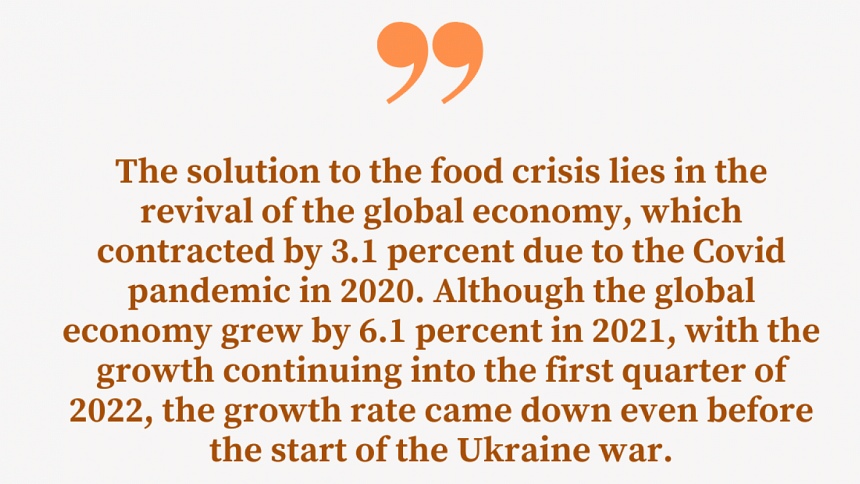What should be Bangladesh’s food security strategy?

The rapid increase in global food prices in recent months have put many countries including Bangladesh in a crisis, especially affecting low and middle-income families as they spend a large share of their income on food. The Food and Agriculture Organization (FAO) Food Price Index has reached 158.5 points, higher than the previous peaks of 132.5 and 137.6, reached during the 2007-2008 and 2011 food crises, respectively. The Russia-Ukraine war, dry weather in several countries, and high prices of agricultural inputs such as fertiliser are responsible for lower food production and higher prices.
Across the world, rising food prices and reduced purchasing power due to inflationary pressure are worsening food security in many countries. Globally, according to FAO, as many as 46 countries including Bangladesh require external assistance to meet their food import needs. As per the Global Report on Food Crises 2022, 193 million people in 53 countries and territories are facing food insecurity.
According to FAO's July 2022 forecast, total global cereal production in 2022 is expected to be 2,792 million tonnes, which is 0.6 percent lower than that of 2021. Ukraine's maize production is forecasted to be 30 percent less than the average output of the last five years. Wheat production will be lower in the European Union, Argentina, and Iraq this year due to drier-than-normal weather, although improved harvest is expected in Canada, Australia, and the Russian Federation. Global rice production is forecasted to be 520.5 million tonnes, 0.4 percent lower in 2022 than in 2021. However, for Bangladesh, as per FAO's forecast, the total cereal production is expected to increase by 1.7 percent – from 62.6 million tonnes in 2021 to 63.6 million tonnes in 2022. Bangladesh imported 4.86 million tonnes of rice and wheat till June 16 in the 2021-22 fiscal year.
Along with the requirement of additional foreign exchange to import food grain, the import of fertiliser and fuel will also put pressure on Bangladesh's foreign exchange situation. Russia and Belarus are the two major fertiliser-exporting countries, and fertiliser prices surged by nearly 20 percent between January and March this year, after they had already shot up three times since January 2021, causing agricultural product prices to rise.
The world trade in cereals is expected to contract by 2.4 percent in 2022-23 from the previous year. Globally, cereal prices have increased by 27.6 percent since June 2021. Wheat price has increased by 48.5 percent. The price of rice has, however, increased by only seven percent during this period. Bangladesh imported four times more wheat than rice in the 2021-22 fiscal year.

Climatic factors such as reduced rainfall and flooding have affected food production in several countries this year. Supply chain related disruptions caused by the Russia-Ukraine war – reducing exports from the Russian Federation and Ukraine and leading to higher global prices of agricultural inputs – are difficult to deal with. Moreover, the tight monetary policy pursued by developed economies to address inflationary trends has reduced the availability of credit to deal with falling foreign exchange reserves that are crucial for the import of food, fuel, and fertiliser. The depletion of foreign exchange reserves due to payment of higher import bills against stagnant export volume is causing currency depreciation. This is forcing countries to adopt austerity measures, including restrictions on imports that are having adverse impact on household income.
The solution to the food crisis lies in the revival of the global economy, which contracted by 3.1 percent due to the Covid pandemic in 2020. Although the global economy grew by 6.1 percent in 2021, with the growth continuing into the first quarter of 2022, the growth rate came down even before the start of the Ukraine war due to global supply chain disruptions and record public debt. The International Monetary Fund (IMF) has reduced the global growth forecast for 2022 by 0.8 percentage points to 3.6 percent. The lower growth rate will affect the income levels of the poor and vulnerable people and their effective demand for food will go down which will exacerbate poverty and malnutrition.
Bangladesh has been trying to tackle the sharp rise in food and fuel prices in a number of ways. Foremost among them is a deficit financing policy in both the last year's and the current year's budgets, with a gap of 6.2 percent and 5.4 percent of GDP, respectively. Bangladesh had to devalue the taka against the US dollar this year. This is expected to have a positive effect on export in due course. However, the tight monetary policies in the developed West and contraction of the global economy are challenges, against which the government has focused its attention to raising domestic resource mobilisation and employment generation to keep economic growth at a reasonably high level. The total public expenditure is earmarked to increase by 14.2 percent in FY2022-23 from the previous budget. Public services, education and technology, and transport and communication are three top sectors where budgetary expenditure will increase by 21 percent, 14 percent, and 24 percent, respectively, from the revised budget of last year.
To encourage the export sector and ensure stable foreign exchange inflow, the government has created a special fund of Tk 5,000 crore for salaries and wages of export-oriented industries. The export development fund has been nearly doubled to Tk 55,200 crore in FY2022-23. Also, an additional Tk 73,000 crore has been set aside for affected industries and service sector enterprises, and Tk 40,000 crore for lending against working capital for cottage, micro, small and medium enterprises (CMSMEs). The success of the government's strategy will, however, depend on adequate mobilisation of domestic resources.
Dr Nawshad Ahmed, an ex-UN official, is an economist and urban planner.

 For all latest news, follow The Daily Star's Google News channel.
For all latest news, follow The Daily Star's Google News channel. 








Comments